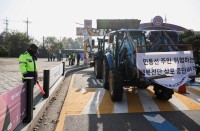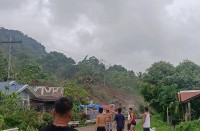
Libyan pro-government forces pressed an advance against the Islamic State group in the coastal city of Sirte as they pushed to clear jihadist holdouts from residential areas. Pro-government forces said they had seized new ground in “residential district two”, another part of Sirte under jihadist control, as well as a radio station used by the jihadists to broadcast propaganda. / AFP PHOTO /
by Mahmud Turkia
SIRTE, Libya (AFP) — Forces loyal to Libya’s UN-backed unity government on Sunday pushed into the last areas of Sirte held by the Islamic State group in what was the jihadists’ coastal stronghold.
The battle for the hometown of Libya’s slain dictator Moamer Kadhafi was launched more than three months ago by forces loyal to the Tripoli-based Government of National Accord.
IS captured the Mediterranean city in June 2015, sparking fears they would use it as a launchpad for attacks on Europe.
“The final battle for Sirte has started,” said Reda Issa, a spokesman for the pro-GNA forces, as loyalist forces thrust into two districts of the city where IS still holds positions.
About 1,000 pro-GNA fighters were taking part in the offensive against “district number one and district number two”, in northern and eastern Sirte respectively, he said.
An AFP photographer saw several tanks and armed vehicles move towards district number one and heard gunfire and rocket explosions as they entered the area.
“Fierce street battles” took place during the day with pro-GNA forces using weaponry including heavy artillery, the photographer said. He said the fighting later became more sporadic.
Late Sunday, a loyalist field commander, Hisham Abdel Atti, said pro-GNA forces had seized “two thirds of district number one and large parts of district number three”.
The jihadists are “retreating”, he said in remarks carried by the media centre dedicated to the Sirte offensive.
At least 34 loyalists were killed on Sunday and 150 wounded, a field hospital for the pro-GNA forces said.
The AFP photographer saw several wounded men being evacuated to the field hospital.
The bodies of two IS fighters lay on a street inside district number one, he said.
Suicide bombers
The pro-GNA forces said on Facebook the offensive came “after air strikes overnight” and as they pressed the assault the jihadists countered with car bombs.
“The Daesh gangs committed mass suicide today when they sent five car bombs and a suicide bomber to try and stop our advancing forces,” a statement said without elaborating.
Since August 1, US warplanes have backed the assault to expel IS from Sirte, and as of August 24 had carried out 82 strikes, according to the US Africa Command.
The AFP photographer reported no air strikes on Sunday.
The pro-GNA forces fought their way into Sirte on June 9 and two months later seized the jihadists’ headquarters at the Ouagadougou conference center, pinning down IS fighters near the sea.
But their advance has been slowed by snipers, suicide bombings and booby traps.
Loyalist forces are mostly militias from western cities that have sided with the unity government of prime minister-designate Fayez al-Sarraj and the guards of oil installations that IS has repeatedly tried to seize.
Ahead of Sunday’s assault, they prepared their tanks for inspection, cleaned their weapons and deployed on the outskirts of Sirte and around the two districts.
“I’m cleaning my weapon… and getting it ready for the decisive battle,” one fighter, Osama Mohammad Mosbah, told AFP.
Snipers on roofs
Sirte had been tense but calm since Thursday.
But fighting erupted Saturday on the edges of district number one between the jihadists and loyalist forces armed with machineguns and rocket launchers, the AFP reporter said.
Pro-GNA snipers deployed on the roofs of buildings whose facades were still painted with the jihadists’ black flag, and used binoculars to scan their surroundings for IS fighters.
More than 370 pro-GNA fighters have been killed and nearly 2,000 wounded in the battle for Sirte since May, according to medical sources. IS casualty figures are unavailable.
Analysts say that ousting the jihadists from Libya would be a symbolic boost for the country’s fragile unity government, but would not mean an end to unrest in the North African nation.
IS could launch more scattered attacks across Libya, they say.
The jihadist group took advantage of chaos in Libya after the 2011 uprising that toppled and killed Kadhafi, as rival militias and authorities have vied for control of the oil-rich country.
A UN-brokered deal struck in December led to Sarraj’s unity government taking office in the capital Tripoli, but it has since struggled to fully assert its authority.
The presidential council headed by Sarraj said on Wednesday it would present a new cabinet line-up in an attempt to secure the backing of parliament.
The legislature, which rejected a previous unity government in a vote on Monday, gave the council a “final chance” and 10 days to propose a new cabinet.
© 1994-2016 Agence France-Presse







